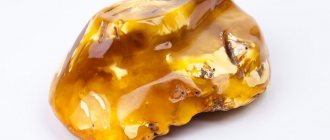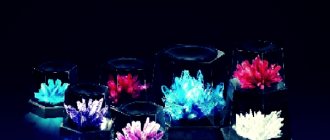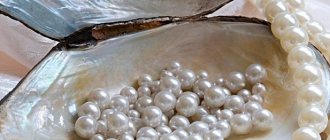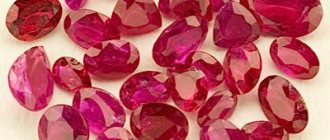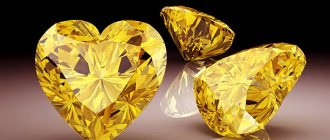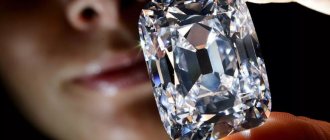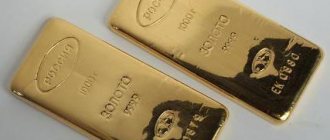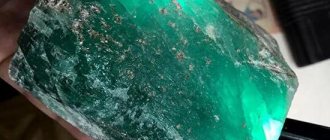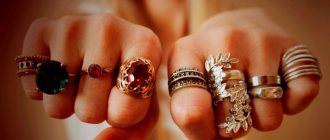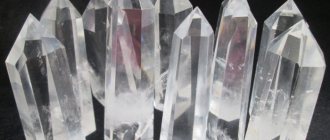Sapphire is counterfeited more often than other stones. How to distinguish a real stone from a fake? Most people simply don’t think about it because they buy jewelry in specialized stores. But will this guarantee the authenticity of the crystal?
Jewelry is often made with synthetic, artificially grown sapphires. Such a crystal is not considered a fake in the literal sense of the word. But you can’t call it natural either. How can you tell them apart? Of course, the optimal solution to this issue is to conduct a professional examination. But not every person is ready to take earrings or a necklace, bracelet, pendant or cufflinks to experts, especially if the jewelry is presented as a gift. The authenticity of this crystal can be determined at home; you just need to know what exactly to look at and how to do it.
What characterizes a natural crystal?
Real crystals formed in nature are never ideal. The impeccable appearance of the mineral decorating the product is the main reason to doubt its natural origin.
When examining a stone to determine its authenticity, you need to pay attention to the following characteristics:
- Structure.
- Color.
- Transparency.
- Tactile sensations.
- Glitter and cut.
Synthetic crystals are similar in many characteristics to natural ones and are not much inferior to them in appearance. Therefore, it is very difficult to distinguish a real crystal from one grown in a laboratory on your own at home.
Appearance of the gem
Sapphire is a subtype of corundum. Initially, this stone has different shades of blue, from bright blue to purple. There are also yellow, powdery, green and amber-colored gems. In terms of chemical components, it is aluminum oxide, the structure of which contains impurities of iron and titanium. It is due to these components that the stone has a rich blue tint. The mineral is distinguished by its rigidity and refractive power, which gives it a pronounced shine.
The unprocessed mineral is distinguished by its uneven outline and color intensity. It is processed using a variety of methods. The most common are the facet cut and the cabochon technique, which makes the surface of the mineral smooth and smoothes out the edges. The facet cut is different in that it can be used to give the stone a variety of shapes, for example, a heart, a triangle or an octahedron. It is this type that is most often used for processing star sapphires, the structure of which contains rutile. The most valuable gemstones are deep blue, the shade of which is close to cornflower blue. Pale blue and dark blue minerals are not valued as highly.
Attention! Red sapphires do not occur in nature. Corundum, which has a rich red and garnet hue, is called ruby.
Color
A mineral formed under natural conditions is never characterized by a completely uniform, deep blue color. It is this quality that allows you to distinguish real sapphire from artificial one.
If there are other shades, it is the original, but its cost is much lower than in the case of a single color. Minerals of other colors are also common in nature: pink, yellow, orange, green, black.
The color of a natural mineral contains minor color impurities and other shades. As a rule, they are concentrated near inclusions present in the crystal. These impurities are noticeable when examining sapphire through a magnifying glass.
Stone analogues
Not only sapphire, but also many other natural gems have a blue color in nature. The following can be passed off as noble corundum:
- cordierite (“water sapphire”);
Water sapphire - kyanite;
Blue kyanite stones - blue tourmaline;
Blue tourmaline - tanzanite;
Tanzanite - blue noble spinel.
Blue noble spinel
There are even more analogues of low-quality yachts - cloudy, opaque. Blue glass is also common among fakes.
Tactile sensations
The main difference between synthetic sapphire and natural one is the sensation that the mineral causes upon contact.
Real crystal leaves a cooling sensation on the skin to the touch.
A mineral artificially grown in a laboratory may be indistinguishable from the real thing in appearance, but it does not cause a cooling sensation when it comes into contact with the skin. But this verification method is not suitable for fake stones that are made on the basis of natural ones. With its help, only synthetic varieties can be distinguished.
Features of artificially grown samples
Jewelry is rare in nature, which is why its value is constantly growing. The price of substitutes produced in laboratories is significantly lower. At the same time, only a professional can distinguish a fake from a natural gem. That is why synthetic analogues are in particular demand and popularity.
Externally, the synthetic mineral is also not very different from the natural one. And thanks to modern manufacturing technologies, the product can be given virtually any shade and saturation. Hydrothermal or nanosapphires are grown from scratch or made from corundum. You can give them the desired tone using coloring. The chemical component of natural and artificially grown pebbles is aluminum oxide. They also do not differ in Mohs hardness (9 out of 10 points).
Luster and cut
Sapphire is a crystal that is characterized by dichroism. That is, an exceptional, bright shine. For this reason, minerals are processed in a very fancy way, trying to form as many faces as possible.
Anyone who has at least once had the opportunity to buy jewelry with precious stones in a reputable store that cares about its reputation knows that a so-called product passport is attached to the jewelry. It contains information about the cut.
Class “A” is the highest; with this cut, maximum symmetry and bright shine are achieved. As a rule, only large sapphires weighing more than a carat are processed in this way. Of course, a product with such a stone cannot be cheap. If the cut is made in class “A”, the crystal itself is large, but the item costs little – this indicates that synthetic sapphire was used in the jewelry.
Other cut classes, “B”, “C”, “G”, are used on small stones, which, as a rule, are used by jewelers in combination with other minerals.
The jewelry passport provides information not only about the type of cut of the mineral, but also about the stone itself. Therefore, when purchasing products with sapphires in a reputable store, you can be sure that the mineral is natural or, conversely, synthetic.
Mineral mining sites
The largest share of sapphire production comes from deposits in Australia. But most of the minerals mined in this country are of poor quality and value. The most expensive stones are those mined in the Indian states of Kashmir and Jammu. They are distinguished by their excellent cornflower blue hue, which can decorate any piece of jewelry. The high price of Indian sapphire is due to small mining volumes. After all, stone deposits are located high in the mountains, and collection occurs manually.
Average quality stones are found in Thailand, but deposits have dried up over the last century. In the gem market, instead of Thai sapphires, Cambodian sapphires of the same quality are presented. Deposits of stones of various colors are scattered all over the world, but only in Tanzania can you find specimens that can change color. Stones mined in Russia are not of particular value due to the lack of characteristic transparency and brilliance. Back to contents
Weight
The weight of the stone is calculated in carats (1 carat is a fifth of a gram). A large mineral has a mass of >1 carat, medium 0.99-0.3 carats, small ones 0.01-0.29. Accordingly, the more a mineral weighs, the more expensive it is.
Sapphire weight by size
| Stone shape | Size | Weight (carat) |
| Circle | 2 | 0.04 |
| 2.5 | 0.08 | |
| 3 | 0.15 | |
| 3.5 | 0.25 | |
| 4 | 0.35 | |
| 5 | 0.65 | |
| 6 | 1.00 | |
| 7 | 1.6 | |
| Oval | 5x3 | 0.35 |
| 6x4 | 0.6 | |
| 7x5 | 1.00 | |
| 8x6 | 1.5 | |
| 9x7 | 2.20 | |
| 10x8 | 3.10 | |
| 12x10 | 6.00 | |
| 14x10 | 7.25 | |
| Square | 2x2 | 0.06 |
| 3x3 | 0.25 | |
| 4x4 | 0.45 |
Magic properties
Sapphire is a stone endowed with many magical properties. Stellar corundum is especially strong, on the surface of which a three- or six-rayed star glides.
The stone is considered a symbol of power. The person who owns it is unconditionally recognized as a leader and controls the masses. And this is understandable, because: it strengthens masculinity, forms a wise perception of life, helps to recognize the essence of other people’s judgments, strengthens the nervous system, protects against the consequences of envy, the evil eye and witchcraft. Being a strong talisman, it warns of danger threatening the owner, attracts like-minded people and drives away enemies. It is believed that this stone chooses its owner. His appearance is considered a gift from heaven.
All sapphires have magical properties, but their effect also depends on the setting. A stone in silver gives restraint, composure, and wisdom. Set in gold, it conveys courage, determination, and a victorious attitude.
The energy direction is determined by the color of the stone.
- Yellow. It is recognized as a stone of creators because it gives inspiration and activates dormant supernatural abilities. Brings harmony into family life, promotes mutual understanding between spouses. The yellow gem accumulates goodness and at the right moment shares it with the owner, relieving him of depressive moods and stress.
- Blue. It treats physical rather than mental ailments more successfully: it strengthens the heart and eyesight. If it is also a star stone, it helps to find and keep love. Good for scientists seeking to understand the secrets of the world. Facilitates learning and develops mental abilities. An equally valuable quality is to guide a person along the right path in life and strengthen leadership abilities.
- Black. It will protect you from enemies, make you believe in yourself, give you determination, protect you from negativity and depression, and attract financial well-being. This stone is especially valued by magicians and is used in various rituals. It is believed that sapphire connects the worlds and comes to the rescue when communicating with otherworldly forces.
- Blue. Supports and develops abilities, including extrasensory ones, opens the “third eye”, develops the mind, and promotes choice in a difficult situation.
- White. Helps achieve a goal, especially if it concerns the spiritual sphere.
- Green sapphire is a reconciliation stone. It reconciles warring relatives, smooths out rough edges in relationships between people, eliminates selfish tendencies, and promotes memorization and interpretation of dreams.
- Pink protects young people, especially girls, from temptations. At the same time, it attracts a passionately adored person of the opposite sex to the owner.
- Star sapphires can protect against deception.
Sapphire can be used as a love spell.
Color does not matter in this case. Place the stone in a glass of wine, cover it with your palms and think about your loved one. They go to bed with these thoughts. In the morning, the stone is taken out and the object of one’s love is given to drink the wine. The effectiveness of such a recipe when executed by an ignorant person is zero, but the karmic consequences for trying to violate the will of another person will definitely have to be experienced by yourself after some time. The magical properties of sapphire should be used only for good purposes. The stone will become a faithful assistant, an excellent amulet and a talisman for a person with pure thoughts. It will protect the owner from damage and the evil eye, breaking the insidious thoughts of ill-wishers. It will warn the owner about the danger that threatens the owner with its tarnishing.
For women, the gem is good because it makes them more attractive, brings harmony, tranquility, and fidelity to family life. Jewels that are passed down from generation to generation have special power.
Men under the influence of sapphire calm down, become more reasonable, and more tender with their spouse. If we are talking about a male leader, the stone helps him competently lead the team, be more decisive, and more purposeful.
It is recommended to take the stone on trips as a talisman against any misfortunes.
What types of fakes are there?
They learned to counterfeit precious stones at the same time they began to be mined. Sometimes a fake looks no worse than the original, and even a jeweler finds it difficult to determine whether an item contains an original natural crystal or not without special tests. But, fortunately, such cases are very rare. As a rule, the jewelry presented in stores does not contain particularly high-quality fakes.
The stones passed off as natural sapphires are:
- fake glass;
- doublet;
- cheap crystals of natural origin;
- artificial, laboratory-grown minerals.
Synthetic sapphires are usually not passed off as natural, since this is not particularly necessary. The price of a high-quality artificial crystal is not much lower than the cost of the original natural mineral.
We carry out identification
It is impossible to determine the authenticity of a sapphire without special equipment with 100% probability.
The maximum that can be done at home is to distinguish fake glass. To determine authenticity, jewelers use a special liquid in which a real sapphire is kept afloat while other stones sink, a refractometer, an ultraviolet lamp and a number of other special devices.
A natural crystal is practically no different from a synthetic crystal in color, appearance and physical properties. The only guarantee is the reputation of the seller. The purchased stone (no matter whether it is an independent unit or an element of a product with sapphire) must have a quality certificate indicating whether it is synthetic or a natural product. If the stone is natural, then the certificate indicates whether it has been refined or not.
Nowadays, most stones are refined by annealing or other manipulations. These procedures are aimed at improving their quality. An ennobled crystal is not considered a fake, but a note about this should appear in its “passport”.
Checking the authenticity of a sapphire ring
The refined stone is determined by illumination with ultraviolet irradiation. If it has been annealed, it will give a greenish glow in ultraviolet light. Natural sapphire glows white under a lamp.
The main methods of differentiation are aimed at distinguishing blue corundum from glass or other crystals.
- Look the stone up to the light. Sapphire slightly changes its hue when illuminated, when it is turned first on one side or the other to the light stream. This is the phenomenon of dichroism.
- Crystal differs from glass in its increased hardness and sharp, clear edges.
- Tanzanite can be suspected by its reddish tint.
- Kyanite - by the presence of longitudinal stripes.
- Spinel is dark and cloudy compared to sapphire. It is issued only for sapphires of low-value varieties.
How to distinguish a sapphire from a fake yourself?
You can determine whether a piece of jewelry is fake or not at home. Of course, with this method of verification you cannot be sure of the result, but it will be a reason to contact experts or, on the contrary, it will reassure and convince you of the authenticity of the stone.
A combination of the following methods can help distinguish an original from a fake:
Mechanical impact. Natural or natural sapphire, unlike synthetic, has sharp corners and flat edges. The mineral has high hardness and strength; in these parameters it is second only to the hardest stone - diamond.
Either the same crystal or a diamond can leave damage on a mineral. At the same time, the stone easily leaves marks on hard surfaces: for example, glass.
Try to draw a scratch on a crystal: a natural one will not get any marks, but a fake one will have a crack.
However, this method is not entirely correct; tourmaline can also scratch glass. For such a check, it is necessary to select an inconspicuous area on the crystal.
Visual assessment of color and structure. To visually evaluate a piece of jewelry, bright lighting and a magnifying glass are required. The structure of the original mineral is heterogeneous, but there are no voids or bubbles inside, and there is also no clear gradation of color changes. Also, sapphire does not change color when lighting changes, unlike similar cheap crystals.
The original stone does not have bubbles in its structure. Since fraudsters are familiar with this feature of the stone, they have learned to fake this characteristic, so this method does not provide final confidence in the authenticity of the sapphire.
Monobromonaphthalene solution. There is another more reliable way to determine whether a sapphire is real or not. The product is placed in a jar with monobromonaphthalene solution. The container is placed on a clean, white sheet of paper and illuminated from the side with bright light. This allows you to see inclusions in the form of stripes. Natural sapphire inclusions have a straight shape, while fake ones have a curved shape.
The asterism effect - a special inclusion in the form of a hexagonal star - is of particular value for jewelers. It is easy to distinguish the original of such a copy from an analogue: smooth rotation in the case of the original leads to a displacement of the sprocket, while in the case of a fake it will remain in the center. Fraudsters have not yet learned how to effectively fake this effect.
Inspection under ultraviolet rays. Under ultraviolet light, sapphire exhibits light reflections. This is a specific quality of natural stone that similar inexpensive minerals do not have. As a rule, fakes have a greenish, cloudy sheen.
Color. Another reliable way to identify a mineral is the color of the sample. When the lighting changes, the color of a fake also changes, unlike the original. The initial assessment is carried out during the day in bright sunlight, then the stone is assessed using bright artificial lighting.
A change in color in several tones indicates that the sapphire is a fake.
If the crystal has been subjected to heat treatment, this is recorded in the relevant documents. The stone is then evaluated under ultraviolet rays. A fake sapphire will have a green tint, and the natural mineral will show itself with a light reflection.
Do you know how to distinguish a real sapphire from a fake?
Not really
Mechanical impact
A natural gem has sharp corners and smooth edges. In terms of hardness and strength, it is inferior to the strongest crystal – diamond. Only the same sapphire or diamond can damage it. But it easily scratches a hard surface, like glass.
You can check a sapphire by drawing a groove. Nothing will happen to the natural one; a mark will remain on the fake.
But this is not an absolute indicator. Tourmaline also scratches glass.
It is better to recognize a gem in this way in an inconspicuous area.
Foreign matter analysis
Natural conditions and the thousands of years during which crystals form differ from those in the laboratory. Therefore, you can determine the authenticity of a crystal visually:
- A high-quality stone must have inclusions and a heterogeneous structure. Visible under a magnifying glass or in bright daylight.
- The inclusions, visible to the naked eye, are characteristic of natural low-grade specimens.
- This one does not contain gas bubbles like glass. But this is not a 100% method, because the authors of the fakes have studied similar things.
- To determine the origin, the sample is placed in a jar of monobromonaphthalene. The container is placed on white paper and a light source is placed on the side. With this lighting, inclusion-strips are visible. In natural stone they are straight, in fake ones they are curved.
Specimens with the asterism effect, that is, inclusion in the form of a six-rayed “star,” are valued. It is easy to distinguish such a sapphire from a fake. With a smooth rotation of a natural gem, the star moves, but the imitation one remains in the center. They cannot fake the effect yet.
A good way to check authenticity. The color of a natural crystal does not change under different lighting conditions. Therefore, the sample is evaluated outside during the day, then under the light of a light bulb. A difference of several tones indicates a fake.
If the certificate indicates that the stone has undergone heat treatment, it is checked under ultraviolet light. Synthetic ones will have a greenish tint, while natural ones have white highlights.
Formal methods
Determining the authenticity of a sapphire using methods available to the average person is ambiguous. Of no small importance in how to distinguish natural sapphire from an artificial sample is the help of specialists. The relevant documentation - passport and certificate - must be studied thoroughly, on an individual basis.
Verification of documents
If you don't want to get into trouble, find a jewelry store with a good reputation: such organizations are ready to provide a certificate confirming the authenticity of each precious stone.
The jeweler must provide information regarding the cut of the piece.
Almost every mineral undergoes a number of procedures aimed at refining the stone. During this process, the sapphire is fired or treated with X-rays. Original stones tolerate this treatment quite well, but the synthetic sample acquires a striped structure.
One of the most reliable signs of quality is the cost of sapphire. The original gemstone is expensive.
Invitation of an expert
To eliminate any remaining doubts, when purchasing a product, contact an independent jeweler or gemologist to assess the quality. An expert can provide an initial opinion directly in the store.
To ensure a guaranteed result, you will need to analyze the sapphire using special methods and equipment.
Contacting an expert involves paying for his services, but this amount is insignificant in relation to the cost of the original stone. This will ensure your peace of mind and save your nerves.
Verification methods that cannot be used
There is no point in checking the crystal by scratching the glass with it. Most gemstones leave scratches on the glass. To guarantee the authenticity of the sapphire, you can try to scratch its surface with a crystal having a hardness of less than 8 Mohs units - there will be no damage to the yacht. “Testing strength” with metal will also not give results - corundum is harder than any type of steel.
You cannot test it “for hardness” by rubbing it with sandpaper. Emery abrasive is made from artificial diamond or chemical compounds of similar hardness. It will spoil any gem, regardless of its nature.
Medicinal properties
Healers have long studied the healing properties of sapphire, discovering new ones. Traditionally, it is recommended to use the stone to enhance the treatment of heart ailments, asthma, skin diseases, diabetes, migraines, kidney diseases, musculoskeletal disorders, and mental disorders. It is customary to take into account the color of the mineral, since stones of different colors have their own specific characteristics.
- Yellow helps fight depression, stress, strengthens the immune system, and has a positive effect on all body systems. It is not recommended to constantly wear a stone or jewelry made of yellow sapphire, as the strong energy of the mineral can cause anxiety.
- Green protects against insomnia and nightmares. Just put it under your pillow at night. Like most green gems, it promotes visual acuity.
- Blue helps in the treatment of skin rashes and reduces inflammation. Especially indicated for heart patients. Helps recover from heart attacks and strokes. Relieves severe headaches.
The properties of sapphire stone are clearly manifested for women, as it helps treat gynecological diseases and relieves reproductive problems.
The healing properties of the gem were admired in Rus'. They called it “wise” because they were sure that it strengthens memory, helps to remain sane until old age, promotes the thinking process, and even rejuvenates the body. Healers from other countries also speak about the ability of sapphire to fight sclerosis and senile insanity. It is called a stone of longevity because it stabilizes blood pressure, partially neutralizes the adverse effects of solar activity on the body, and strengthens the general well-being of older people.
It is recommended to wash your face with sapphire water. To do this, early in the morning a crystal is dipped into the liquid for two hours. Infused water relieves inflammation, tightens the skin, and treats eye diseases. A migraine attack will subside if you apply a compress with sapphire water to your forehead.
Uncut stones are more suitable for medicinal purposes.
Modern people's belief in the healing properties of sapphire is not as strong as in ancient times. But, you must admit, even the simple contemplation of a precious stone of amazing beauty and magical reflections of light on its many facets calms and pacifies. And quality relaxation promotes health.
